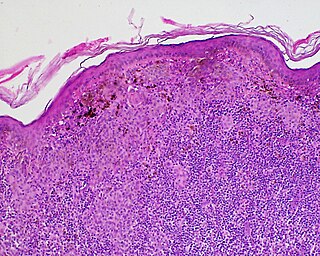Related Research Articles

Melanocytes are melanin-producing neural crest-derived cells located in the bottom layer of the skin's epidermis, the middle layer of the eye, the inner ear, vaginal epithelium, meninges, bones, and heart. Melanin is a dark pigment primarily responsible for skin color. Once synthesized, melanin is contained in special organelles called melanosomes which can be transported to nearby keratinocytes to induce pigmentation. Thus darker skin tones have more melanosomes present than lighter skin tones. Functionally, melanin serves as protection against UV radiation. Melanocytes also have a role in the immune system.

Vitiligo is a long-term skin condition characterized by patches of the skin losing their pigment. The patches of skin affected become white and usually have sharp margins. The hair from the skin may also become white. The inside of the mouth and nose may also be involved. Typically both sides of the body are affected. Often the patches begin on areas of skin that are exposed to the sun. It is more noticeable in people with dark skin. Vitiligo may result in psychological stress and those affected may be stigmatized.

Ajwain, ajowan, or Trachyspermum ammi—also known as ajowan caraway, thymol seeds, bishop's weed, or carom—is an annual herb in the family Apiaceae. Both the leaves and the seed‑like fruit of the plant are consumed by humans. The name "bishop's weed" also is a common name for other plants. The "seed" is often confused with lovage "seed".

Café au lait spots, or café au lait macules, are flat, pigmented birthmarks. The name café au lait is French for "coffee with milk" and refers to their light-brown color. They are also called "giraffe spots," or "coast of Maine spots," which refers to their jagged borders.

Mycosis fungoides, also known as Alibert-Bazin syndrome or granuloma fungoides, is the most common form of cutaneous T-cell lymphoma. It generally affects the skin, but may progress internally over time. Symptoms include rash, tumors, skin lesions, and itchy skin.
PUVA is an ultraviolet light therapy treatment for skin diseases: Eczema, Psoriasis, Graft-versus-host disease, Vitiligo, Mycosis Fungoides, Large-Plaque Parapsoriasis and Cutaneous T-Cell Lymphoma using the sensitizing effects of the drug psoralen. The psoralen is applied or taken orally to sensitize the skin, then the skin is exposed to UVA.

The congenital melanocytic nevus is a type of melanocytic nevus found in infants at birth. This type of birthmark occurs in an estimated 1% of infants worldwide; it is located in the area of the head and neck 15% of the time.

Piebaldism is a rare autosomal dominant disorder of melanocyte development. Common characteristics include a congenital white forelock, scattered normal pigmented and hypopigmented macules and a triangular shaped depigmented patch on the forehead. There is nevertheless great variation in the degree and pattern of presentation, even within affected families. In some cases, piebaldism occurs together with severe developmental problems, as in Waardenburg syndrome and Hirschsprung's disease.

The Koebner phenomenon or Köbner phenomenon, also called the Koebner response or the isomorphic response, attributed to Heinrich Köbner, is the appearance of skin lesions on lines of trauma. The Koebner phenomenon may result from either a linear exposure or irritation. Conditions demonstrating linear lesions after a linear exposure to a causative agent include: molluscum contagiosum, warts and toxicodendron dermatitis. Warts and molluscum contagiosum lesions can be spread in linear patterns by self-scratching ("auto-inoculation"). Toxicodendron dermatitis lesions are often linear from brushing up against the plant. Causes of the Koebner phenomenon that are secondary to scratching rather than an infective or chemical cause include vitiligo, psoriasis, lichen planus, lichen nitidus, pityriasis rubra pilaris, and keratosis follicularis.
Trachyonychia, is a condition characterized by rough accentuated linear ridges on the nails of the fingers and toes. When the condition occurs on all the twenty nails of the fingers and toes, it is known as twenty-nail dystrophy, most evident in childhood, favoring males.

Halo nevus is a mole that is surrounded by a depigmented ring or 'halo'.

Nevus anemicus is a congenital disorder characterized by macules of varying size and shape that are paler than the surrounding skin and cannot be made red by trauma, cold, or heat. The paler area is due to the blood vessels within the area which are more sensitive to the body’s normal vasoconstricting chemicals.
Alezzandrini syndrome is a very rare syndrome characterized by a unilateral degenerative retinitis, followed after several months by ipsilateral vitiligo on the face and ipsilateral poliosis. Deafness may also be present.

Lelis syndrome it is a genetic disorder, a rare condition with dermatological and dental findings characterized by the association of ectodermal dysplasia with acanthosis nigricans. Other clinical features may include palmoplantar hyperkeratosis, nail dystrophy, intellectual deficit, disturbances of skin pigmentation and hypodontia. Transmission is autosomal recessive.
Vitiligo ponctué is a cutaneous condition, an unusual form of vitiligo, characterized by small confetti-like or tiny, discrete macules that may occur on otherwise normal or unusually darkened skin.

Nevus depigmentosus is a loss of pigment in the skin which can be easily differentiated from vitiligo. Although age factor has not much involvement in the nevus depigmentosus but in about 19% of the cases these are noted at birth. Their size may however grow in proportion to growth of the body. The distribution is also fairly stable and are nonprogressive hypopigmented patches. The exact cause of nevus depigmentosus is still not clearly understood. A sporadic defect in the embryonic development has been suggested to be a causative factor. It has been described as "localised albinism", though this is incorrect.
Symmetrical drug-related intertriginous and flexural exanthema (SDRIFE), more popularly known as Baboon syndrome because of its resemblance to the distinctive red buttocks displayed by female baboons, is a systemic contact dermatitis characterized by well-demarcated patches of erythema distributed symmetrically on the buttocks. The cause of the syndrome may be drug-related, i.e. induced by systemic administration of hydroxyzine penicillin, iodinated radio contrast media and others.
Progressive macular hypomelanosis is a common skin condition, a disorder, observed more frequently in young women with darkly pigmented skin who originate from or reside in tropical climates.
Melanoma-associated leukoderma is a cutaneous condition, and is a vitiligo-like depigmentation that can occur in patients with cutaneous or ocular melanoma.
References
- ↑ Rapini, Ronald P.; Bolognia, Jean L.; Jorizzo, Joseph L. (2007). Dermatology: 2-Volume Set. St. Louis: Mosby. p. 917. ISBN 978-1-4160-2999-1.
| This cutaneous condition article is a stub. You can help Wikipedia by expanding it. |